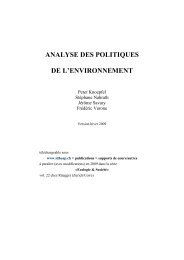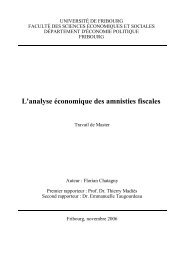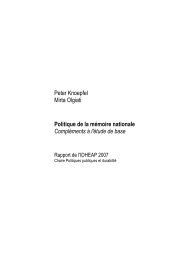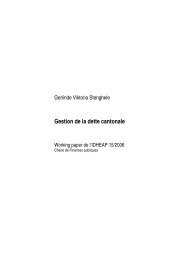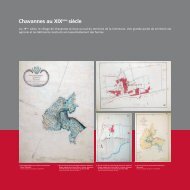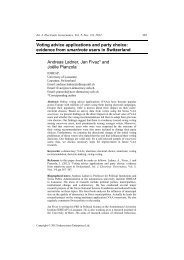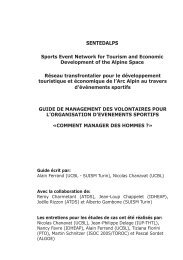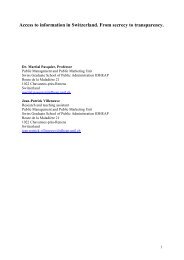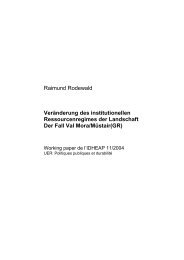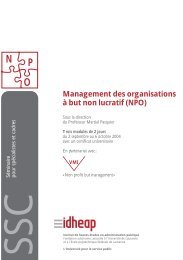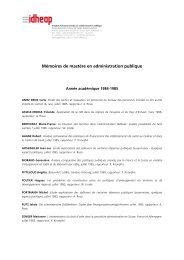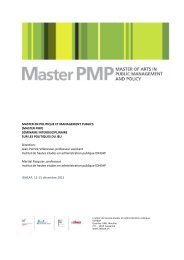Historical Analysis of Institutional Regimes in Switzerland ... - IDHEAP
Historical Analysis of Institutional Regimes in Switzerland ... - IDHEAP
Historical Analysis of Institutional Regimes in Switzerland ... - IDHEAP
Create successful ePaper yourself
Turn your PDF publications into a flip-book with our unique Google optimized e-Paper software.
26<br />
• The trend towards the <strong>in</strong>creas<strong>in</strong>g restriction <strong>of</strong> property rights was halted at least tentatively <strong>in</strong> the<br />
1980s. Thus, for example, as the compensation payments for nature conservation values show,<br />
disposal <strong>of</strong> the latter is added to the owner’s property. The only way its use can be <strong>in</strong>fluenced is<br />
through compensation payments.<br />
• The path dependence <strong>of</strong> IRs should be extremely important for the current form <strong>of</strong> the IR “In a<br />
world <strong>of</strong> purposive actors, it may <strong>in</strong>deed be the case that the effects <strong>of</strong> an <strong>in</strong>stitution have<br />
someth<strong>in</strong>g to do with an explanation for its emergence and persistence. Arguments about path<br />
dependence, however, suggest the large dangers <strong>in</strong> any assumption that an exist<strong>in</strong>g <strong>in</strong>stitution<br />
arose or cont<strong>in</strong>ued to exist because it serves some particularly useful purpose.“ (Pierson 1997:<br />
39) The concept <strong>of</strong> path dependency places the historical explanation centre-stage. In this<br />
context, path dependency means that events or shocks can have completely different effects,<br />
depend<strong>in</strong>g on the sequence <strong>of</strong> events. For example, all natural resources were affected by the<br />
economic boom <strong>of</strong> the post-war period. The effects with respect to regime control were,<br />
however, very different, depend<strong>in</strong>g on the exist<strong>in</strong>g regulations.<br />
• Both property rights and policy <strong>in</strong>struments have a significant <strong>in</strong>fluence on actors’ behaviour.<br />
Therefore, the synopsis <strong>of</strong> an <strong>in</strong>stitutional economic and policy analysis perspective is very useful<br />
and does <strong>in</strong>crease the steer<strong>in</strong>g capacity <strong>of</strong> resource management by reveal<strong>in</strong>g discrepancies<br />
(between user groups, uses and rules) and by <strong>in</strong>duc<strong>in</strong>g harmonisation <strong>of</strong> needs and rules.<br />
• This <strong>in</strong>itial empirical comparison <strong>of</strong> the IRs for the five selected resources <strong>in</strong> <strong>Switzerland</strong> shows<br />
that a an empirical variance exists which is extensive <strong>in</strong> some cases. Hence, it would appear<br />
essential that this variance be expla<strong>in</strong>ed <strong>in</strong> theoretical terms. For future research, therefore,<br />
hypotheses shall be formulated and concretely tested to make it possible to expla<strong>in</strong> the<br />
emergence, development and effects (on the resources) <strong>of</strong> different IRs (the <strong>in</strong>itial approximate<br />
<strong>in</strong>dications for possible hypotheses are formulated under 4.3).<br />
Moreover, we have demonstrated that the proposed IR concept can be applied empirically (for very<br />
different resources), reveals new research questions and could lead to a critical exam<strong>in</strong>ation <strong>of</strong><br />
previous hypotheses. Before such a research programme is developed, as a prelim<strong>in</strong>ary conclusion,<br />
we will now briefly summarise the added value <strong>of</strong> the IR approach.<br />
6 Conclusion: The Usefulness <strong>of</strong> the IR Approach<br />
The advantages and added value <strong>of</strong> the IR approach can be summarised as follows:<br />
• Study <strong>of</strong> heterogeneous uses <strong>in</strong>stead <strong>of</strong> (s<strong>in</strong>gle) homogeneous use: one limitation <strong>of</strong> the CPR<br />
theory is that it focuses on a s<strong>in</strong>gle use (cf., for example, the criticism <strong>of</strong> Ste<strong>in</strong>s/Edwards 1999).<br />
An approach based on the multiple-use IR is much more realistic <strong>in</strong> <strong>in</strong>dustrialised countries. It<br />
also stresses the redistributive effects <strong>of</strong> IR change between different user groups (social<br />
dimension <strong>of</strong> susta<strong>in</strong>ability).<br />
• Resource perspective (stock and flows) allows consideration <strong>of</strong> all the goods and services<br />
provided by a resource, <strong>in</strong>clud<strong>in</strong>g those goods and services that have yet to be discovered. This<br />
facilitates a parallel consideration <strong>of</strong> protection and exploitation/use policy.<br />
• The <strong>in</strong>tegration <strong>of</strong> resource policies and order-policy <strong>in</strong>tervention (cf. comments on Figure 2)<br />
makes it possible to draw a dist<strong>in</strong>ction between formal/legal property rights (private law) and<br />
<strong>in</strong>formal but real use rights (public law, self-regulation).



